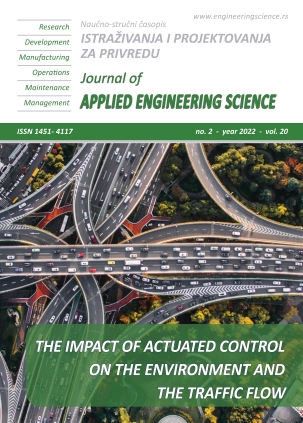DERRICK CRANE ROBUSTNESS SCENARIOS
Abstract
The paper deals with derrick cranes (derricks), that are equipment typically used in mining industry and the focus is the analysis of few robustness scenarios. Derricks are composed by built-up steel members, which are widely and efficiently used in hoisting applications, due to theirs high payloads at relevant outreaches. As during the in-service use local damages might occur, aim of the paper is to study how such damages should influence the overall structural performance. In particular, reference has been made to a derrick for which six geometrical configurations and five different damage scenarios have been analyzed. Owing to the extensive use of angles in the built-up component of each derrick, structural analyses have been carried out by using a commercial refined finite element analysis package (FEAP) offering the warping torsion as additional degree of freedom for each beam node. Research outcomes allow for a clear identify the parts of derrick which should be protected and well-designed to guarantee a robust structure for the total in-service life.
References
Shapiro, L. K., Shapiro, J. P. (2010). Cranes and derricks. McGraw-Hill Education, 4th New-York. ISBN: 9780071625579 007162557.
UCIMU (2017). Guide to application of the Machinery Directive 2006/42/EC. Edizioni TNE, 2nd
Spasojevic-Brkic, V., Golubovic, T., Milanovic, D.D., Brkic, A. (2014). Crane operators anthropomeasures factors identification. Journal of Applied Engineering Science, vol. 12, no. 2, 159-164. doi: 5937/jaes12-5409.
Dondur, N., Spasojevic-Brkic, V., Brkic, A. (2012). Crane cabins with integrated visual systems for the detection and interpretation of environment – Economical appraisal. Journal of Applied Engineering Science, vol. 10, no. 4, 191-196. doi: 5937/jaes10-2516.
Feng, M., Xiao, H., Zhang, Z., Lu, S. (2010) Mechanical stress analysis of port crane based on the condition of temperature field. ICIMIA 2010, 2nd International conference on industrial mechatronics and automation, vol. 1, art. no. 5538057, 172-176. doi: 1109/ICINDMA.2010.5538057.
Cai, F., Wang, X., Liu, J., Zhao, F. (2014). Fatigue life analysis of crane K-Type welded joints based on non-linear cumulative damage theory. Journal of mechanical engineering, vol. 60, no. 2, 135-144. doi: 5545/sv-jme.2013.1368.
Lee, H. H. (1998). Modeling and control of three-dimensional overhead crane. Journal of dynamic systems, measurement and control, transactions of the ASME, vol. 120, no. 4, 471-476. doi: 10.1115/1.2801488.
Abdel-Rahman, E.M., Nayfehn, A.H., Masoud, Z.N. (2003). Dynamics and control of cranes: A review. JVC/Journal of vibration and control, vol. 9, no. 7, 863-908. doi:1177/1077546303009007007.
Abdullahi, A.M., Mohamed, Z., Selamat, H., Pota, H.R., Zainal Abidin, M.S., Fasih, S.M. (2020). Efficient control of a 3D overhead crane with simultaneous payload hoisting and wind disturbance: design, simulation and experiment. Mechanical Systems and signal processing, vol. 145, 106893. doi: 1016/j.ymssp.2020.106893.
Solazzi, L. Zrnic, N. Design of a high-capacity derrick crane considering the effects induced by load application and release. Journal of Applied Engineering Science, vol. 15, no. 1, 409, 15-24, 2017. doi: 5937/jaes15-11930.
Solazzi, L. (2020). Effect of recurrent impulse load actions on a Crane. FME Transactions, vol. 48, no. 2, 266-271. doi: 5937/fme2002266S.
Solazzi, L., Scalmana, R. (2013). New design concept for lifting platform made of composite material. Applied composite materials, vol. 20, no. 4, 615-626. doi: 1007/s10443-012-9287-2.
Bernuzzi, C., Bertinotti, E., Simoncelli M. (2017). Structural analysis of built-up members with angles. Journal of Applied Engineering Science, vol. 18, no. 3, 443-457. doi: 5937/jaes18-24459.
Zandonini, R., Baldassino, N., Freddi, F. (2014). Robustness of steel-concrete flooring systems – An experimental assessment. Stahlbau, vol. 83, no. 9, 608-613. doi: 1002/STAB.201410192.
Diaz, E., Soria, L., Gallardo, J.M. (2019). Post-failure life evaluation: a corrosion-fatigue case history. Engineering failure analysis, vol. 105, 828-836. doi: 1016/j.engfailanal.2019.07.022.
DIN15018-1:1984 (1984). Cranes steel structures, Verification and analyses, Deutsche norm.
FEM 1.001 (1998), rules for the design of hosting appliances, federation europeene de la manutention, 1998.
EN13001-1 (2015), Cranes – General design – Part 1: General principles and requirements, Brusselles, 2015.
ConSteel v. 13, FE software, http://www.consteelsoftware.com/en, accessed 2019.
Vlasov, V. Z. (1961). Thin-walled elastic beams. Published for The National Science Foundation, Washington D.C., by the Israel Program for Scientific Translations, Jerusalem.
Bleich, F. (1952). Buckling strength of metal structures. Engineering societies monograph, McGraw Hill, New York. ISBN 10: 0070058903.
EN1993-1-1, Eurocodice 3 (2015), Design of steel structures – Part 1-1: General rules and rules for builsings, CEN.
Bernuzzi, C., Cordova, B., Simoncelli, M. (2015). Unbraced steel frame design according to EC3 and AISC provisions. Journal of Constructional Steel Research, vol. 114, 157-177, 4247. doi: 1016/j.jcsr.2015.07.012.

